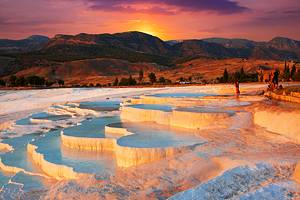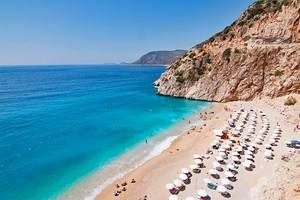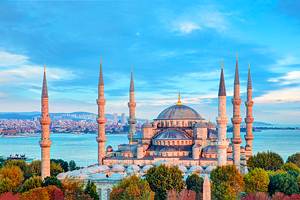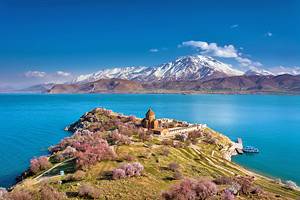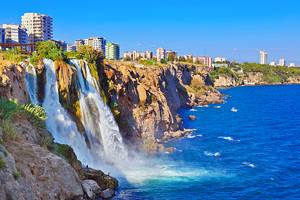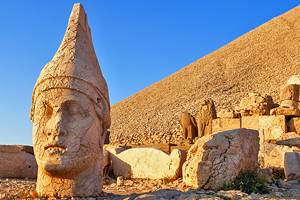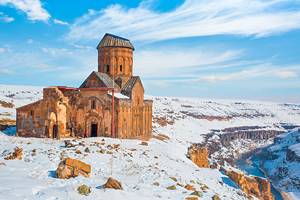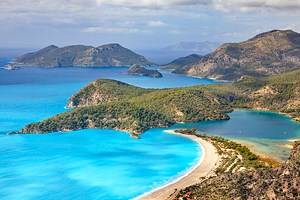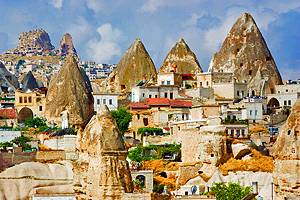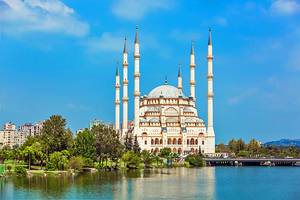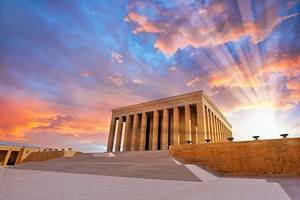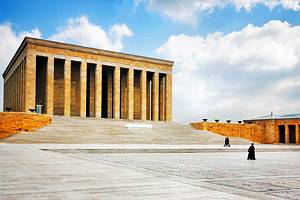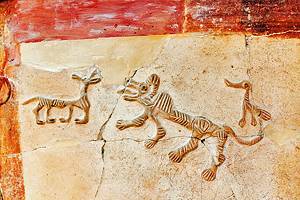Mosques in Turkey
Turkey is home to some of the most historically important and beautiful mosques in the world. For travelers interested in art, architecture, culture, or heritage, visiting a few mosques should be high on the things to do list during your Turkey travels.
Istanbul offers some of the most famous imperial mosques of the Ottoman era, but there are historic mosques across the country. Some of the best surviving examples of the earlier Seljuk era are snaffled away in more out-of-the-way locations and are well worth seeking out.
Mosques are open for non-Muslim visitors as long as you visit outside of prayer times. There is no entrance fee at mosques.
Visitors should be dressed modestly (long-sleeved tops and ankle-length trousers or skirts), and females should bring a scarf to cover their heads. At larger mosques that receive plenty of visitors, there are head scarfs available to be lent in a box at the entrance.
Begin your journey into the rich heritage of Islamic art with our list of the best mosques in Turkey.
Hagia Sophia Mosque
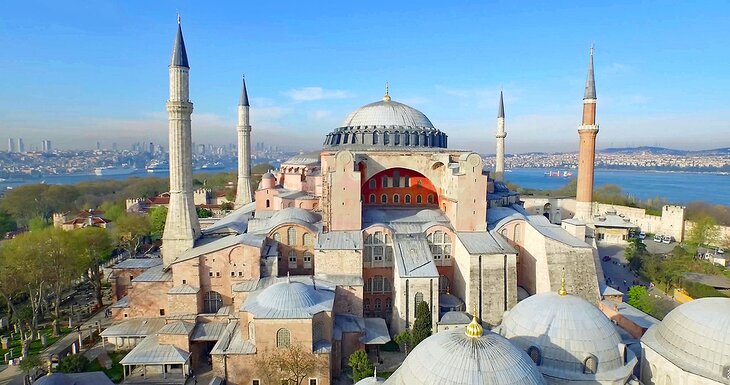
Widely regarded as one of the world's most beautiful buildings, the Hagia Sophia Mosque (Ayasofya-i Kebir Cami) is one of Turkey's most famous tourist attractions.
The Hagia Sophia's long history began life in 537 CE as Byzantine Emperor Justinian's grand church.
It became a mosque in the 15th century and stayed that way through the Ottoman era up to the fall of the Ottomans and the birth of modern Turkey, after which it was converted into a museum in 1935.
In 2020, it once again officially became a working mosque.
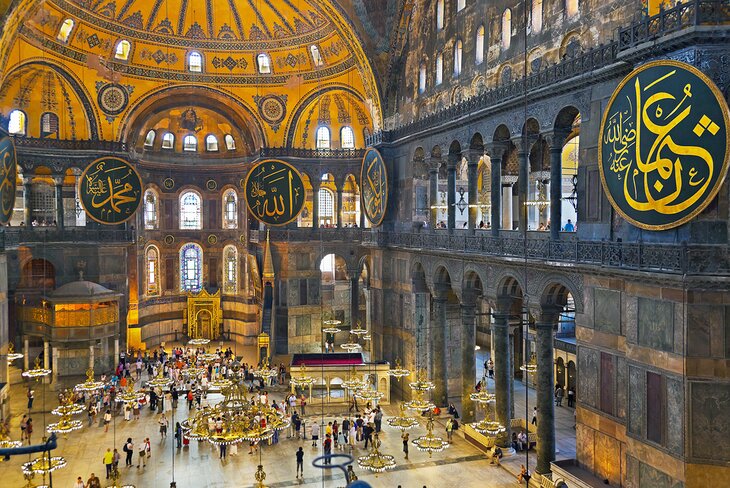
The prayer hall (originally the nave) sits under the vast 56-meter-high dome, decorated with chandeliers, fragments of Byzantine mosaics, huge calligraphy-inscribed medallions, and the section of marble floor known as the omphalion (where Byzantine emperors were crowned).
Don't miss the Christ as Pantocrator mosaic, which decorates the Imperial Door leading into the mosque's prayer hall.
Address: Ayasofya Meydanı 1
Blue Mosque
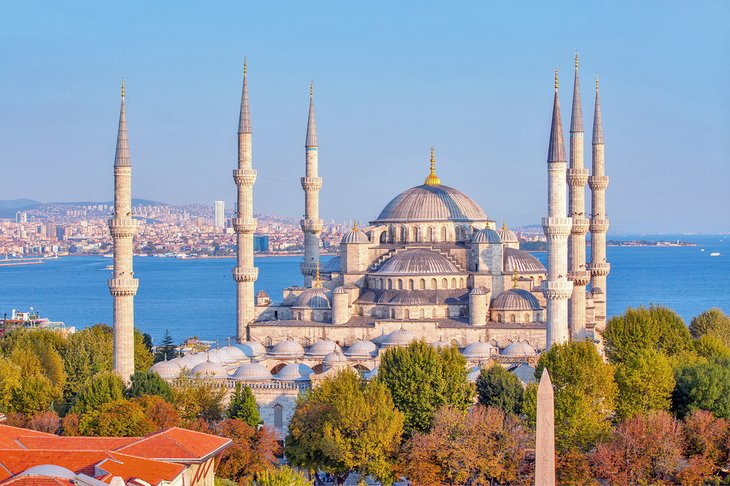
One of Turkey's most famous mosques, Istanbul's Sultanahmet Mosque (Sultanahmet Cami) is more commonly called the Blue Mosque by visitors. It's one of the most important sights in Istanbul.
It sits right in the center of Sultanahmet, the city's old town district, with its domes and minarets a direct architectural rival to the Hagia Sophia dominating the opposite side of Sultanahmet Square.
Built by Ottoman architect Sedefkâr Mehmet Ağa during the reign of Sultan Ahmet I (reigned 1603-1617), the mosque was a stamp of Ottoman imperial power, boasting a controversial six minarets (equalling the same number as Mecca's grand mosque).
The massive prayer hall uses 21,000 Iznik tiles to decorate the interior. The mosque gained its moniker from the prevalent blue tones used on the tiles.
Although the lavish use of tiles gains most of the attention, make sure to note the white marble minber (pulpit) with its delicate carvings, and the mihrab (the wall niche that indicates the direction of Mecca), which contains a piece of the Kabaa's sacred stone from Mecca.
The mosque is a popular Istanbul tourist attraction and so can be crowded with visitors during the day, particularly in summer. For a quieter visiting experience, come in the evening. Touristic visitors enter the prayer hall from the south door, not the main entrance.
Address: Atmeydanı Caddesi 7, Sultanahmet, Istanbul
Süleymaniye Mosque
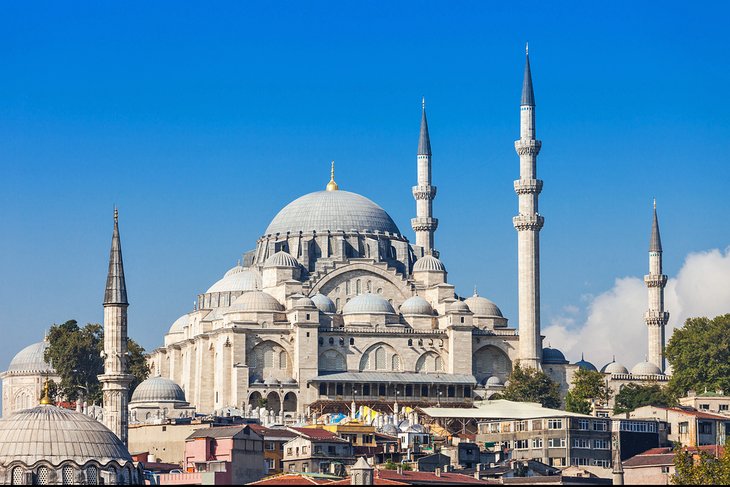
With its hilltop position, the Süleymaniye Mosque (Süleymaniye Cami) is one of Istanbul's most familiar skyline landmarks.
Built during the reign of Sultan Süleyman I ("Süleyman the Magnificent" reigned from 1520 to 1566), this grand architectural project was one of the famous works of Sinan, the Ottoman era's most celebrated architect.
Although superseded in tourist affections by the Blue Mosque, the prayer hall's vast domed interior, with its mihrab of Iznik tiles, stained-glass windows, and elaborately embellished woodwork details creates a more serene interior ambience than the younger mosque down the hill.
The surrounding buildings of the original mosque complex have all survived, and been restored, here, so a visit offers the chance for visitors to imagine how the great Ottoman mosques of the city would have functioned in the imperial heyday. These attached buildings originally housed a soup kitchen, medrese (theological school), inn, and hospital.
The grounds of the mosque are also home to the finely decorated tombs of Sultan Süleyman I and his wife Haseki Hürrem Sultan (also known to historians as Roxelana).
Address: Prof. Sıddık Sami Onar Caddesi 1, Eminönü, Istanbul
Rüstem Paşa Mosque
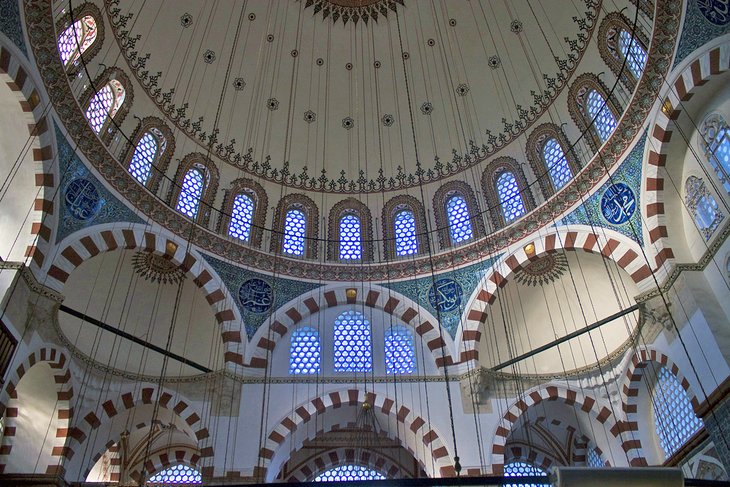
It may not have any of the grand architectural proportions of Istanbul's most famous imperial mosque projects, but if you want to admire spectacular Iznik tile work close-up, don't miss a visit here.
Another Ottoman project built by the architect Sinan, the Rüstem Paşa Mosque (Rüstem Paşa Cami) was financed by Sultan Süleyman I's grand vizier Rüstem Paşa.
The Iznik tile panels here, with their floral and geometric designs, decorate both the mosque's exterior wall and its interior. Because of the mosque's more human scale, it's more possible here to examine their delicate artwork rather than be dazzled by the sheer scale and amount of tile work.
The mosque is set above street level, so it doesn't reveal itself easily to casual passersby. A nondescript staircase from the street, brings you up and out onto the terrace in front of the mosque.
Address: Hasırcılar Caddesi 62, Eminönü, Istanbul
Selimiye Mosque
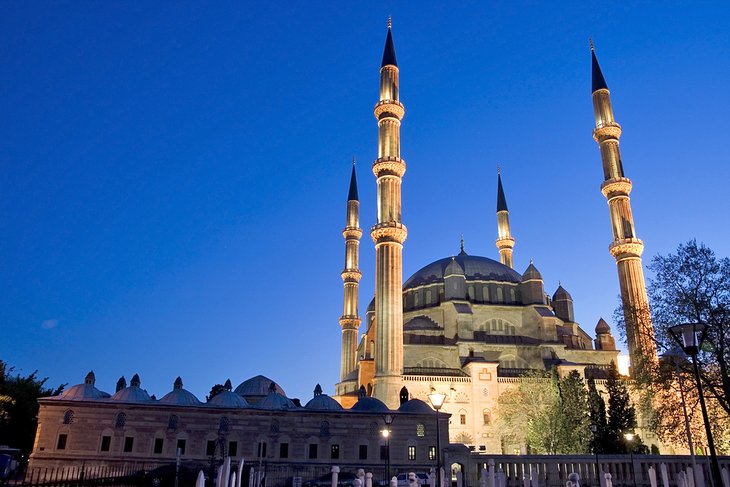
Edirne was the second capital of the Ottoman Empire (after Bursa and before Istanbul), but the city's grandest piece of Ottoman architecture stems from Sultan Selim II's reign (Sultan Süleyman I's son; reigned 1566-1574) and is the work of the imperial court's chief architect, Sinan.
The four slender minarets of the Selimiye Mosque (Selimiye Cami) are a towering 71 meters high. Historians think it probable that at the time of their construction, they were the tallest mosque minarets in the world.
The main interior dome, centered round an octagonal support structure of pillars and arches, measures a vast 31.3 meters in diameter.
Inside, panels of calligraphy and the geometric designs of the arch borders are highlighted by light from hundreds of windows, deliberately focusing visitors' attention on the upper levels and dome of the prayer hall and creating a serene sense of vast space.
Outside, the surrounding grounds of the mosque are home to two museums, both housed in buildings that were used as theological schools as part of the original mosque complex.
Address: Mimar Sinan Caddesi, Edirne
Sultan Beyazıt II Mosque
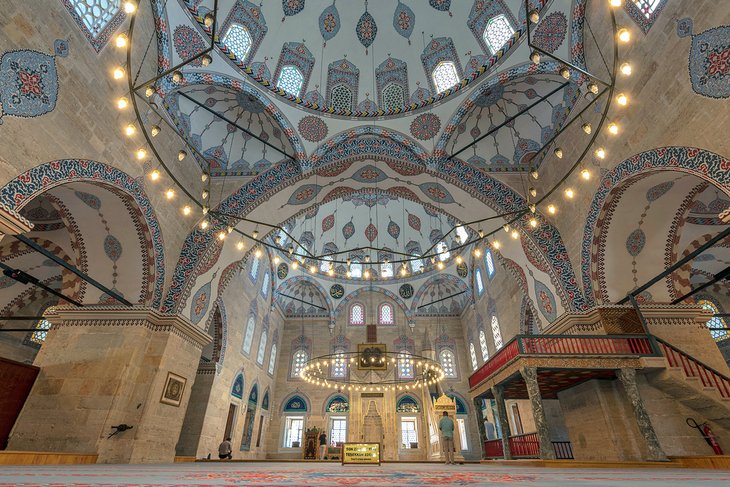
Amasya's Sultan Beyazıt II Mosque (Sultan Beyazıt II Cami) has been overlooking the Yeşilırmak River in the center of town since 1486.
Many of its additional buildings, which made up the original mosque complex, are still standing today amid the mosque's garden, including the structures that formerly functioned as a medrese (theological college) and soup kitchen.
In the front courtyard, before entering the mosque, make sure to note the ablution fountain with its roof, which has highly detailed murals of Amasya painted on its ceiling.
Inside, the prayer hall holds a particularly ornate minber of carved wood and a white marble mihrab but is more impressive for the overall sense of refinement created by the airy, soaring double-domed interior.
Sultan Beyazıt II (reigned 1481-1512) served as governor of Amasya for 27 years before ascending the throne, and although he also has a very fine mosque dedicated to him in Istanbul, it is this one here, built during his reign and overseen by his son Şehzade Ahmet who took over the area's governing role, which is the grandest.
Address: Mustafa Kemal Paşa Caddesi, Amasya
Bursa Grand Mosque
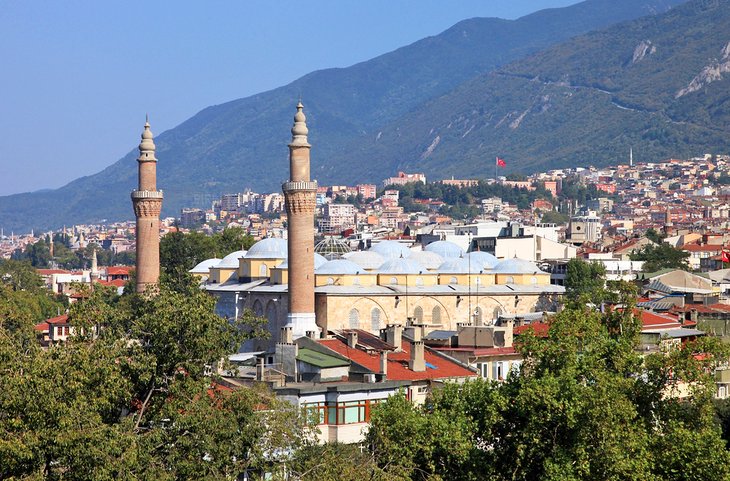
Bursa was the first capital of the Ottoman Empire, and holds a wealth of early-Ottoman architecture.
The city's most famous building, the Grand Mosque (Ulu Cami), sits right in the heart of town, surrounded by a vast bazaar area of well-restored hans (caravanserais), which hark back to Bursa's important trade routes history.
Built by Sultan Beyazıt I (reigned 1389-1402) in 1399, the mosque has a distinct Seljuk style.
The metal roof is comprised of 20 domes. This architectural feature is a result of the sultan's over-ambitious promise to build 20 mosques after defeating the Crusaders. Instead, he built one mosque incorporating that number of domes.
Address: Atatürk Caddesi, Ozmangazı, Bursa
Mahmud Bey Mosque
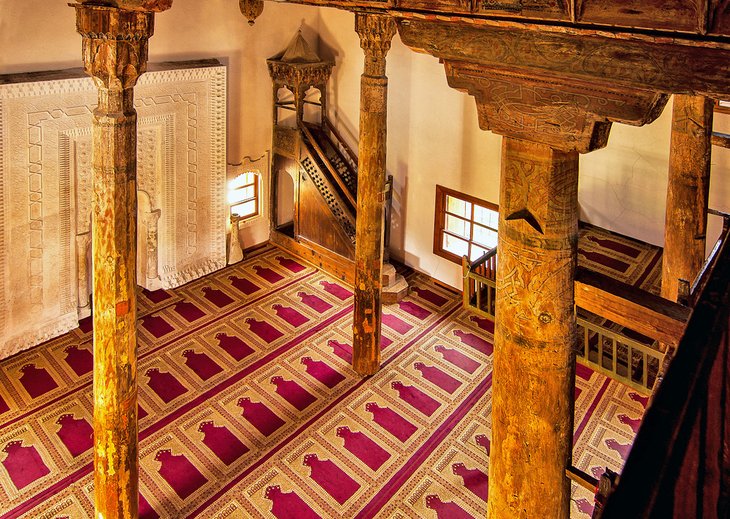
Anyone interested in the artistry of mosque interiors should make a special trip here. Built in 1366, this modest-looking mosque in the hamlet of Kasaba (17 kilometers from the city of Kastamonu) is one of the finest surviving examples of painted-wood mosque interiors in Turkey.
Inside, the wooden ceiling, wooden columns, and ornately carved wooden gallery are all covered in intricate floral and geometric painted patterns that are faded but otherwise well-preserved.
The interior woodwork construction is particularly noteworthy, as it was made without the use of any nails in an interlocking wood joint method known as kundekari in Turkish.
You can climb up to the gallery for close-up viewing of the ceiling's murals.
The mosque's intricately carved door is a replica, but you can view the original in Kastamonu's Ethnography Museum.
Address: Kasaba village, Kastamonu
Divriği Grand Mosque & Darüşşifası
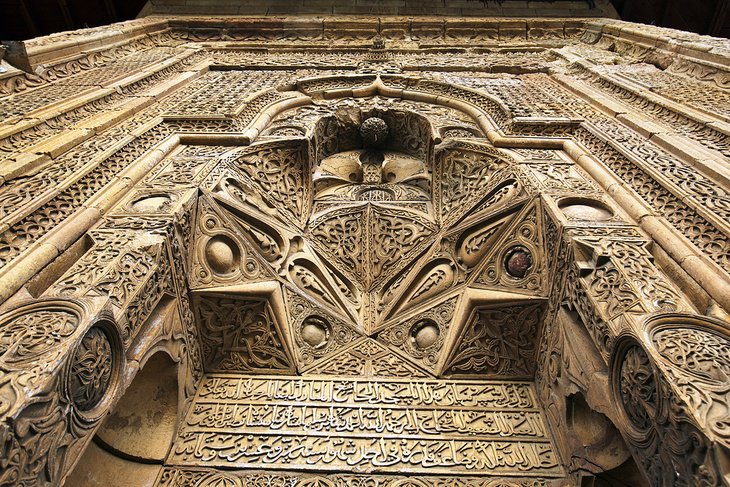
Sitting on a hill overlooking the tiny village of Divriği (166 kilometers southeast from Sivas) is one of Turkey's most beautiful mosque complexes, allotted UNESCO World Heritage Site status for its fine artistry.
Divriği's Grand Mosque (Ulu Cami) and attached darüşşifası (hospital) dates from 1228, when much of Anatolia was ruled over by separate Seljuk-Turk principalities (which would later coalesce into the Ottoman Empire).
Divriği was the capital of one of these principalities, and ruled by Emir Ahmet Şah and his wife Melike Turan Melik who commissioned this ambitious building project.
The stone doorways of the mosque and darüşşifası are its most celebrated feature. The four doorways (one reaching 14 meters high) are covered in richly detailed and intricate carved reliefs of floral motifs, animal designs, and geometric patterns. They are rightly considered a masterpiece of Islamic architecture.
Inside, the vaulted stonework of the mosque and austere but serene darüşşifası interiors are deliberately unadorned, creating a dramatic contrast with the elaborate carvings of the entrances.
Address: Ulu Cami Caddesi, Divriği village
Muradiye Mosque
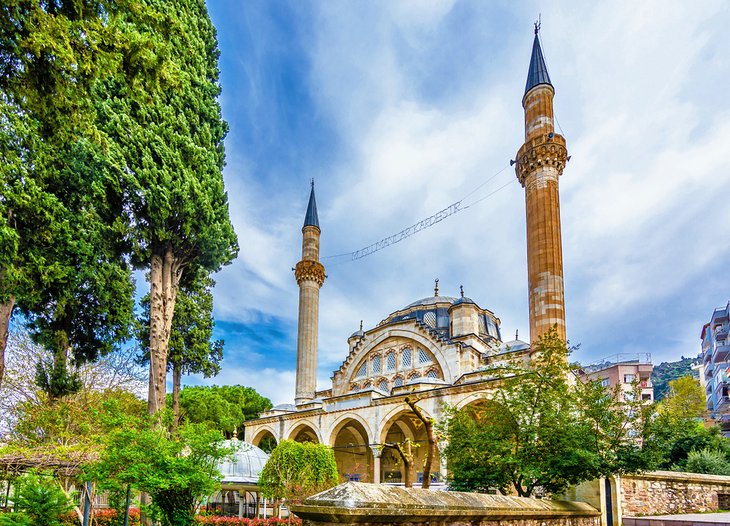
After Sultan Mehmed III (son of Sultan Selim II; reigned 1595-1603) took over the rule of the Ottoman Empire, he commissioned this mosque in the town of Manisa, where he had previously been governor.
Like all the greatest imperial mosque projects built by his father and grandfather before him, the Muradiye Mosque (Muradiye Cami) was designed by the famed architect Sinan.
It's particularly well known for the perfusion of high quality Iznik tilework that covers the interior, particularly the tiled mihrab, all illuminated by stained-glass window detailing.
Don't forget to admire the main door, though, as you enter, with its marble detailing and extravagant wood carvings.
Address: Murat Caddesi, Manisa
Trabzon Aya Sofya Mosque
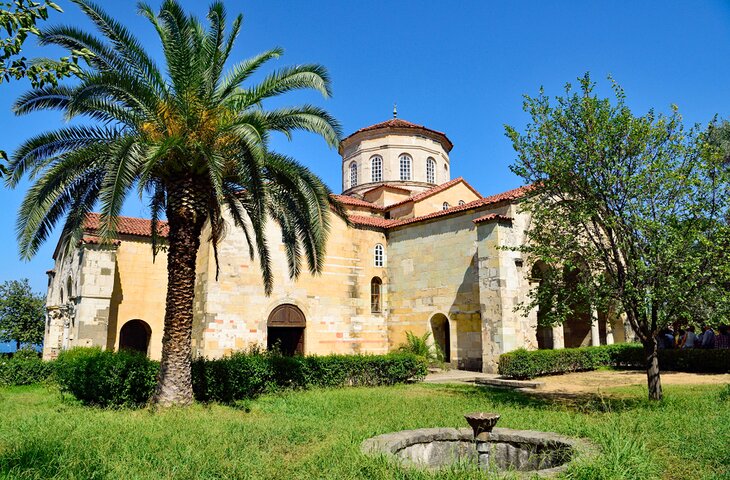
One of the Black Sea region's most famous historical attractions, Trabzon's Aya Sofya Mosque was built in the 13th century. Originally the Hagia Sophia Church, it is an exceptional example of Byzantine architectural style and interior design.
During the 16th century, it was converted into a mosque, although in the early 20th century, when the Russian military occupied Trabzon, it functioned as an arms depot.
The building was restored in the mid-20th century, and from 1964 was declared a museum before being reconverted into a functioning mosque again in 2013.
For years after the mosque reconversion, the colorful 13th-century Byzantine frescoes depicting scenes from the New Testament on the interior dome of the prayer hall were covered, but a recent restoration installed a retractable ceiling, which now allows visitors to view the frescoes outside of prayer times.
Also in the prayer hall, note the section of opus sectile mosaic, made from inlaid multicolored stone, which can be viewed under the glass flooring.
Just to the side of the mosque is a bell tower that dates from the 15th century, and the manicured gardens surrounding the mosque are also home to an Ottoman-era cemetery and remnants of a Roman-era temple.
Address: Zübeyde Hanım Caddesi, Fatih, Trabzon
Şakirin Mosque
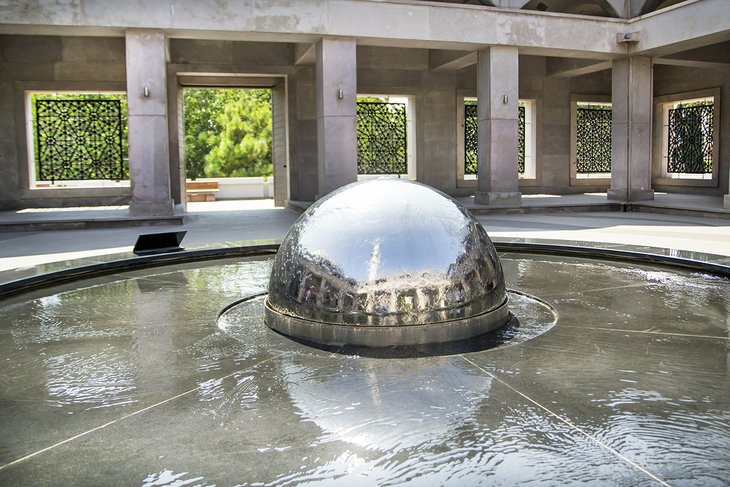
Turkey has plenty of modern mosques, but nearly all follow traditional Ottoman architectural lines. The Şakirin Mosque (Şakirin Cami), in the Istanbul neighborhood of Üsküdar, is one of the best places to visit to view a mosque that eschews conventional style.
Built in 2009, the architect Hüsrev Tayla and interior designer Zeynep Fadıllıoğlu worked together to create a completely contemporary and unique mosque design.
The austere and minimalist stone and aluminum exterior is softened by decorative metal screens. In the courtyard, don't miss the ablutions fountain, with its central grey metal dome, which reflects the mosque façade.
The prayer hall, though, is the highlight of a visit with its acrylic dome mihrab and huge chandelier of water-drop-shaped glass globes, surrounded by glazed walls featuring decorative calligraphy panels.
Address: Nuhkuyusu Caddesi 2, Üsküdar, Istanbul
Sabancı Merkez Mosque
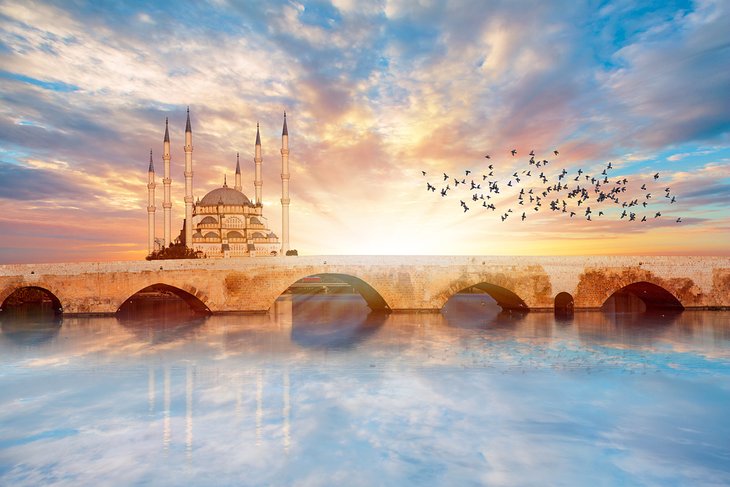
The Sabancı Merkez Mosque (Sabancı Merkez Cami) sits on the bank of the Seyhan River, and its soaring 54-meter-high dome, surrounded by six 99-meter-high minarets, are Adana's major landmark.
Built in 1998, this is one of Turkey's most impressive modern mosques. It is also one of the largest mosques in the entire Middle East, with a capacity of over 28,000 worshippers.
Its architecture and interior design is completely in line with traditional Ottoman style. Calligraphy panels and Iznik tile work are used as decoration amid the austere stone work of the vast prayer hall, lit by multiple windows from above.
Address: Turhan Cemal Beriker Bulvarı, Adana
Manuçehr Mosque
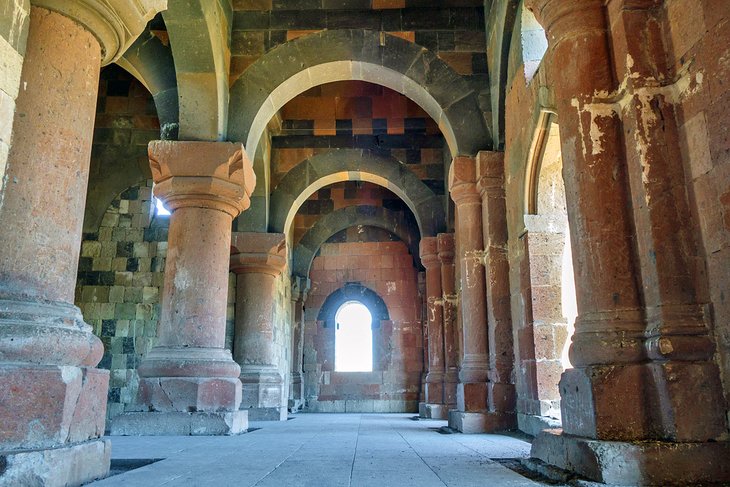
Now one of the monuments sitting on the edge of the high plateau that holds the archaeological site of Ani (46 kilometers east from Kars), the Manuçehr Mosque (Manuçehr Cami) is widely thought by historians to be the earliest Turkish-built mosque in the land that would become Turkey.
It dates to 1072, when the Seljuk Turks had moved west from Persia, taking control of this trading route city and old capital of the Armenian Kingdom.
With its still-standing octagonal minaret and its two-story interior of red-hued stone, home to vaulting details and Seljuk motifs on the ceiling, the mosque is an excellent example of how Ani's Armenian architectural design and the new Seljuk style merged.
İznik Aya Sofya Mosque
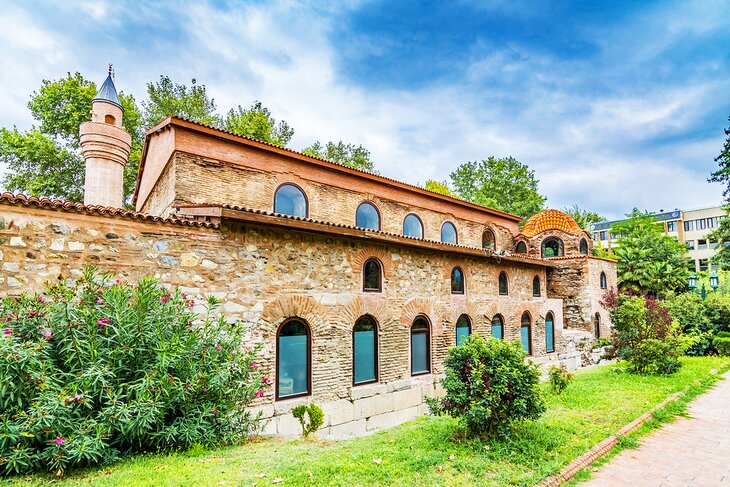
İznik was once the important Byzantine city of Nicaea, and the Aya Sofya Mosque (also known as the Orhan Mosque) dates from the 6th century, when it was built during the reign of the Byzantine Emperor Justinian as the Hagia Sophia Church.
The current building, with its basilica floor plan, dates from the 11th century after the original church was destroyed by an earthquake.
The church was transformed into a mosque after the Ottomans captured Nicaea in the 14th century, and although, like Istanbul's Hagia Sophia Mosque, it was designated as a museum after 1935, İznik's Aya Sofya was reconverted into a working mosque again in 2011.
The interior, with its bare stone walls, is sparse and mostly left unadorned. A section of intricate inlaid mosaic flooring and a fresco depicting the holy family with John the Baptist both dating from the 11th century church can still be seen.
Address: Kılıçaslan Caddesi 163, İznik



